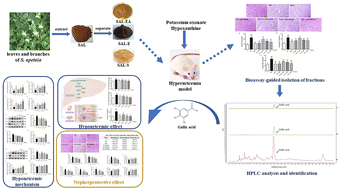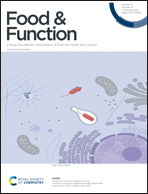Hypouricemic effect of gallic acid, a bioactive compound from Sonneratia apetala leaves and branches, on hyperuricemic mice†
Abstract
As a tropical medicinal plant, Sonneratia apetala is mainly distributed in the southeast coastal areas of China. Recently, the hypouricemic effect of Sonneratia apetala leaves and branches (SAL) has been reported, but the active compound and its mechanism are unclear. Thus, this study aims to explore the effective fraction of SAL and the mechanism of its active compound on uric acid formation and excretion. SAL was extracted with ethyl acetate and concentrated to obtain solvent-free extracts (SAL-EA). The remains fraction (SAL-E) and the supernatant fraction (SAL-S) of SAL resulting from water extraction and alcohol precipitation were collected and dried. The effects of different fractions were explored on hyperuricemic mice. SAL-S showed excellent activities in decreasing the levels of uric acid (UA), blood urea nitrogen (BUN), and creatinine (CRE) in serum and in attenuating kidney damage. Then, the active compound gallic acid (GA) identified by HPLC was assayed for its mechanism of regulating uric acid metabolism in hyperuricemic mice. The hypouricemic effect of GA was probably associated with the downregulation of URAT1 and GLUT9, upregulation of ABCG2 and decreased activities of adenosine deaminase (ADA) and xanthine oxidase (XOD). Moreover, GA suppressed the level of MDA, IL-6, IL-1β, TNF-α, TGF-β1, COX-2 and cystatin-C (Cys-C), and enhanced the activities of SOD, GSH-Px, CAT, and Na+–K+–ATPase (NKA) in the kidneys. These results indicated that GA protects against hyperuricemia-induced kidney injury via suppressing oxidative stress and inflammation as well as decreasing the serum levels of UA by regulating urate transporters.



 Please wait while we load your content...
Please wait while we load your content...